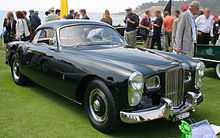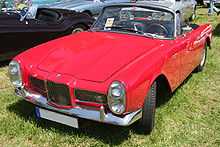Facel
| Industry | Automotive |
|---|---|
| Founded | Facel SA 1939 (Facel-Vega : 1954) |
| Defunct | 1964 |
| Headquarters | Paris, France |
Key people | Jean Daninos |
| Products | Automobiles from 1954 |
Facel was a French manufacturer of automobiles from 1954 to 1964.
The company was named after the original metal stamping company FACEL, and the company's first model, the Vega, named after the star,[1] was introduced at the 1954 Paris Auto Show. The cars were advertised with the slogan For the Few Who Own the Finest.
Initially successful, the company failed after the debut of its mechanically troubled Facellia model.
Company history

The marque Facel Vega was created in 1954 by Jean Daninos (brother of the humorist Pierre Daninos, who wrote Les Carnets du Major Thompson), although the Facel company had been established by the Bonzavia Company in 1939 as a subcontracting company for the aviations industry. FACEL (Forges et Ateliers de Construction d'Eure-et-Loir, in English: forge and construction workshop of the department of Eure-et-Loir) was initially a metal-stamping company but decided to expand into car manufacturing in the early 1950s.[2] Facel entered the automobile business as a supplier of special bodies for Panhard, Delahaye and Simca.
Small numbers of other special bodied cars, such as the Bentley pictured, were also made. Facel also made the pillarless coupé bodywork for the Simca/Ford Comète. Around 45,000 Comètes were built, this lucrative contract enabled Facel to manufacture a car under the Facel marque.
Products
Facel Vega
The Vega production cars (Facel FV, later and more famously the HK500) appeared in 1954 using Chrysler V8 engines, at first a 4.5-litre (275 cu in) DeSoto Hemi engine; the overall engineering was straightforward, with a tubular chassis, double wishbone suspension at the front and a live axle at the back, as in standard American practice. They were also as heavy as American cars, at about 1,800 kg (3,968 lb). Performance was brisk, with an approx 190 km/h (118 mph) top speed and 0 to 100 km/h (62 mph) in just under ten seconds.
Most cars were 2-door hardtops with no centre pillar, but a few convertibles were built. Fully 77% of production was exported, due to the punitive Tax horsepower system in France.[2]
The 1956 model was improved with a bigger 5.4-litre (330 cu in) Chrysler engine and updated transmission and other mechanicals. In the same year production began of a four-door model, the Excellence, with rear-hinged doors (suicide doors) at the back and no centre pillar. The pillarless design unfortunately made it less rigid and the handling was thus poorer than that of the two-door cars, and surviving examples are rare.
1959 models had even bigger engines, a 5.8-litre (354 cu in) and later a 6.28-litre (383 cu in) Chrysler V8, and were quite a bit faster despite their extra weight. The final evolution of the V8 models came in 1962 with the Facel II, which was lighter, with sleeker, more modern lines, substantially faster still, and famously elegant.
Facellia


In 1960, Facel entered the sports car market with the Facellia, a small car similar in size to the then popular Mercedes 190SL. Facellias were advertised in three body styles: cabriolet, 2+2 coupé and 4-seat coupé — all with the same mechanicals and a 2,450 mm (96.5 in) wheelbase. Styling was similar to the Facel HK500, but with rather elegant (though fingernail-breaking) flush door handles. Following Facel Vega's demise several of M Daninos's styling cues were "borrowed" by Mercedes-Benz. Prices were roughly US$4,000 for the Facellia, US$5,500 for the Facel III and US$6,000 for the Facel 6.[3]
With the idea of creating a mass-produced all-French sports car competing with the Alfa Romeos, Facel moved away from American engines. The Facellia had a 4-cylinder 1.6 L DOHC engine built in France by Paul Cavallier of the Pont-à-Mousson company (which already provided manual gear boxes for the company's larger models). The engine had only two bearings supporting each camshaft, using special steels, as opposed to the usual four or five. Despite the metallurgical experience of Pont-à-Mousson, this resulted in excessive flex, timing problems and frequent failures. The engine was pronounced a disaster and the Facellia with it. Company president, Jean Daninos having been obliged to resign in August 1961 in response to the company's financial problems, the new boss, a former oil company executive called André Belin, gave strict instructions to the after-sales department to respond to customer complaints about broken Facellia engines by replacing the units free of charge without creating "difficulties".[4] The strategy was intended to restore confidence among the company's customer base.[4] It would certainly have created a large hole in the income statement under the "warranty costs" heading, but it may have been too late for customer confidence.
The troublesome engine was replaced with a Volvo B18 powerplant in the Facel III, but the damage was done. Production was stopped in 1963 and despite the vision of it being a "volume" car only 1100 were produced, which is Facel's highest production number. Facel lost money on every car they built, the luxury car side of the company being supported entirely by the other work done by Facel Metallon, Jean Daninos's obsession being very similar to that of David Brown of Aston Martin.
The small Facellia met with little success and the losses from this, due to strong competition at the luxury end of the market, killed off the company. Facel left the car market completely in 1964. What was, according to some, the best small Facel, the Facel 6, which used an Austin Healey 2.8-litre engine, came too late to save the company, fewer than 30 having been produced when the French government scuttled the endeavour.
Prominence
Prominent owners of Facel Vegas (mainly of Facel IIs) included Pablo Picasso, Ava Gardner, Christian Dior, Joan Collins, Ringo Starr, Max Factor Jr, Joan Fontaine, Stirling Moss, Tony Curtis, several Saudi princes, Dean Martin, Fred Astaire, Danny Kaye, Louis Malle, The President of Mexico, François Truffaut, Robert Wagner, Anthony Quinn, Hassan II, King of Morocco, Debbie Reynolds, the Shah of Persia, Frank Sinatra, Maurice Trintignant, Brian Rix and French Embassies around the world.[5][6][7] Race-car driver Stirling Moss would drive his HK500 from event to event rather than fly.
The French writer Albert Camus died in a Facel Vega FV3B driven by his publisher, Michel Gallimard.[8] At the time of his death, Camus had planned to travel by train, with his wife and children, but at the last minute accepted his publisher's proposal to travel with him.[9]
In the 1989 film "Dealers", Paul McGann, as Daniel Pascoe, drove a Facel ll.
A Facel Vega HK500 appears in computer-animated form in the film Ratatouille (Pixar, 2007), driven by one of the main characters.
A Facel Vega Facellia appeared in the music video for Caravan Palace's Dramophone.[10]
Models
- Vega FV
- Facel Vega FVS
- Facel Vega HK500
- Facel Vega II
- Facel Vega Excellence
- Facel Vega Facellia
- Facel III
- Facel 6
References
- ↑ "Facel Vega". Chrysler 300 Country.
- ↑ 2.0 2.1 Sedgwick, Michael. "The Facel Vega 1954 - 1964".
- ↑ http://www.nadaguides.com
- ↑ 4.0 4.1 "Automobilia". Toutes les voitures françaises 1962 (salon Paris oct 1961) (Paris: Histoire & collections). Nr. 19: Page 34. 1200.
- ↑ Hervé Alphand, the French Ambassador to the United States, used theirs, an Excellence, from 1956 to 1965. It was sold @ Bonhams in Philadelphia 8 Oct 2012 for $159,000.
- ↑ http://www.youtube.com/watch?v=tQrwbzDTvSQ&feature=youtube_gdata_player
- ↑ Tegler, Eric (March 1, 2007). "1959 Facel Vega HK500: For the Few Who Own the Finest". Autoweek.
- ↑ de Gaudemar, Antoine (1994-04-16), This one's had a good start born in the middle of a move, Guardian, retrieved 2008-12-21
- ↑ "KIAD MA in Fine Art: a student run seminar". Raimes.com. Retrieved 2009-10-17.
- ↑ http://www.youtube.com/watch?v=A7lxd7RL1To
External links
| Wikimedia Commons has media related to Facel S.A.. |